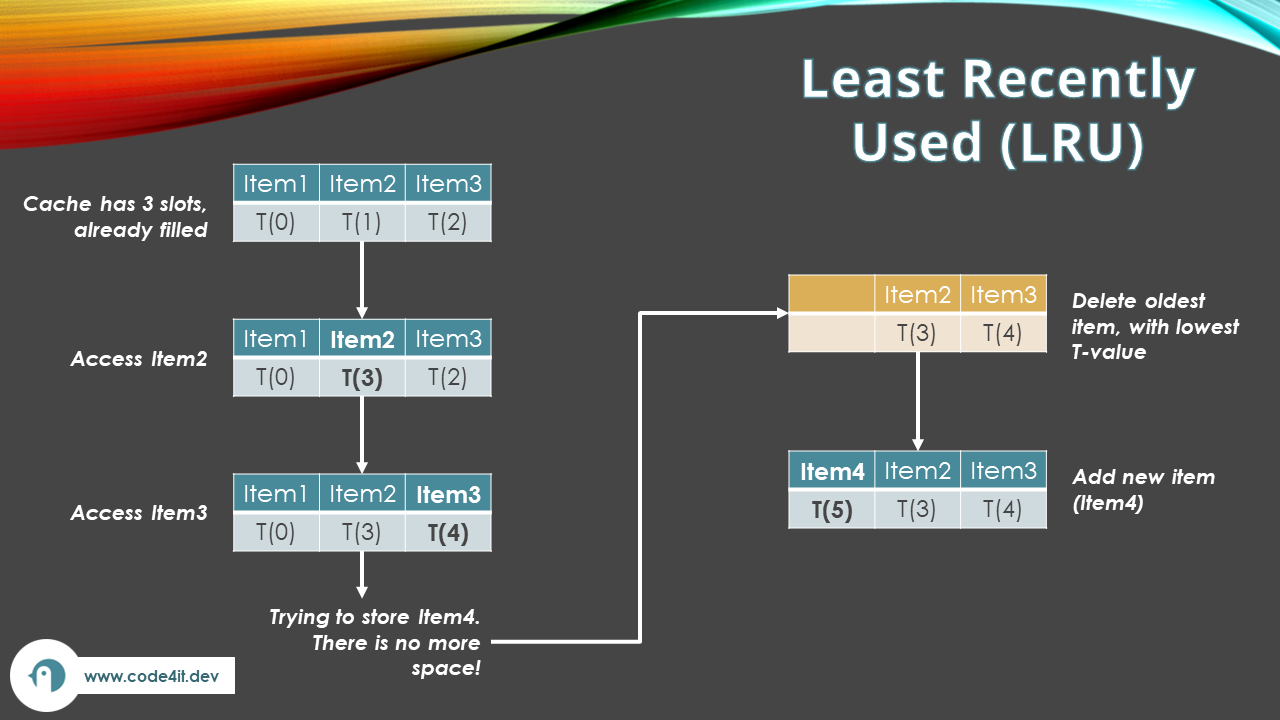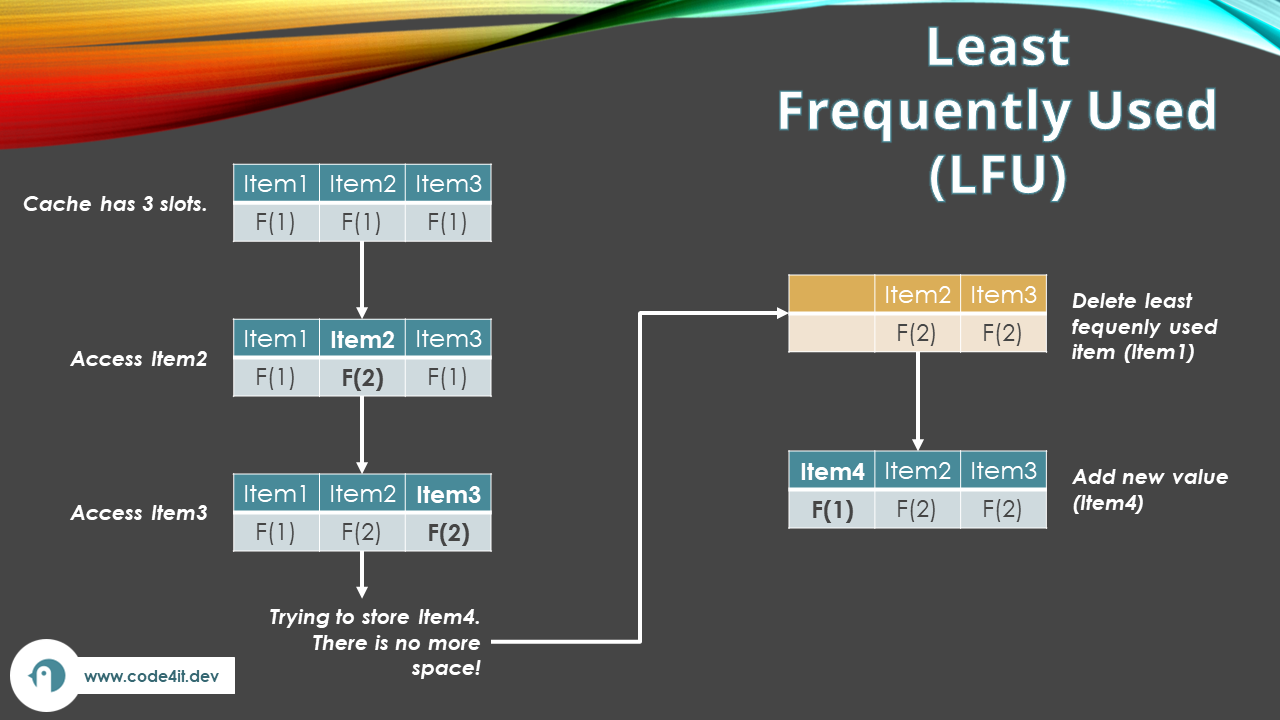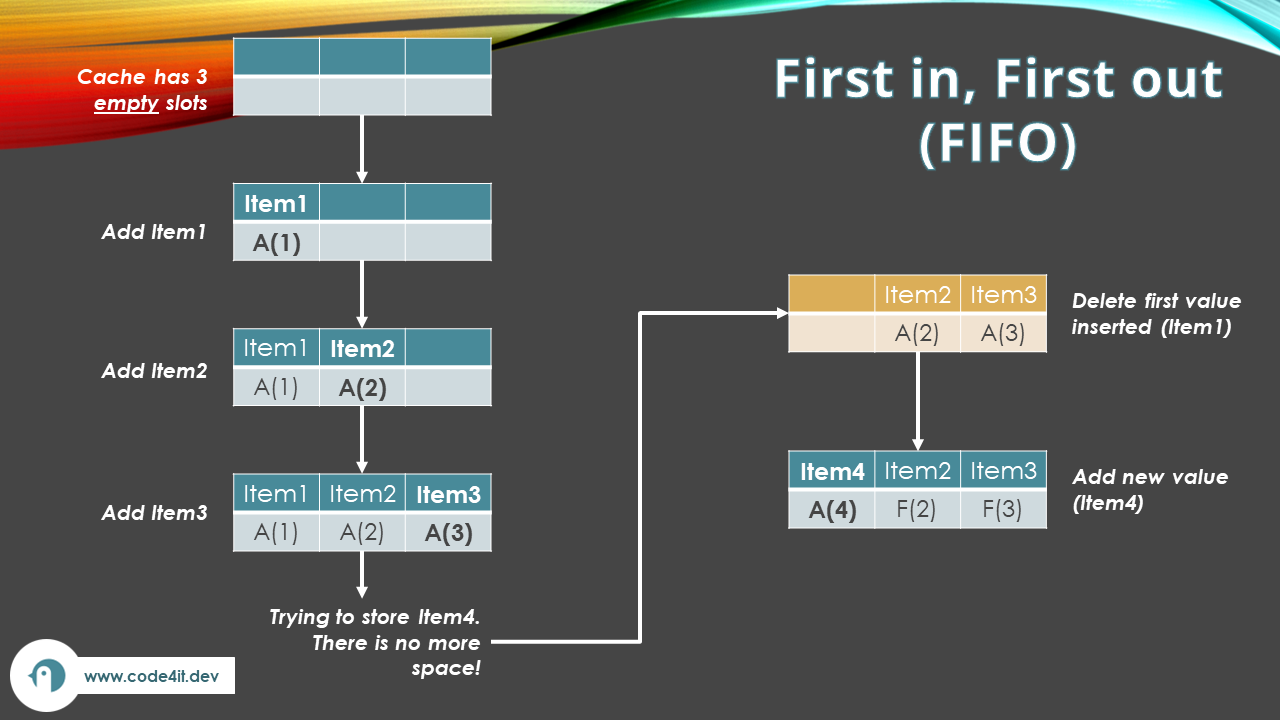Davide's Code and Architecture Notes - Cache Expiration vs Cache Eviction (and Eviction Policies)
Caching helps your applications be more performant. However, depending on the cache size, you’ll need to sacrifice some items to make space for others. Let’s see some strategies.
Table of Contents
Just a second!
If you are here, it means that you are a software developer. So, you know that storage, networking, and domain management have a cost .
If you want to support this blog, please ensure that you have disabled the adblocker for this site. I configured Google AdSense to show as few ADS as possible - I don't want to bother you with lots of ads, but I still need to add some to pay for the resources for my site.
Thank you for your understanding.
- Davide
Caching is one of the most common techniques used to improve application performance by storing some data, usually coming from external sources, in quick-access storage.
Every call to an API, a database, or an external system adds some latency to the operation you are executing. Caching these items results in a faster application.
Similarly, if you have to perform some heavy calculations, doing them over and over again can be a waste of time. So, you might want to store the precalculated values in the storage to avoid doing these heavy calculations.
With caching, you save the data that is heavy to read or generate in a specific storage with one important characteristic: it has fast access. Caching can be done in-memory or by using an external system; the critical part is that you must be able to quickly retrieve a specific using a unique key.
But storage is limited, and you cannot store everything in the cache.
In this article, we will learn how to free up some memory by using Cache Expiration and Cache Eviction; we will then see the most used Cache Eviction Policies to define how and when we should delete items from the cache.
Cache Expiration: items are removed based on the TTL
We can assign a Time-To-Live (TTL) value to each item stored in the cache. When the TTL value is past, the data is considered expired and is removed from the cache. In this case, we are talking about Cache Expiration.
In C#, you can define the TTL by setting a value to the AbsoluteExpirationRelativeToNow property of the MemoryCacheEntryOptions class, like in the following example, where the item is set to expire after 3 seconds from its creation.
var cache = new MemoryCache(new MemoryCacheOptions());
cache.Set("myKey", "myValue", new MemoryCacheEntryOptions()
{
AbsoluteExpirationRelativeToNow = TimeSpan.FromSeconds(3)
});
var exist1 = cache.TryGetValue("myKey", out _);
output.WriteLine($"Exists1: {exist1}"); // TRUE
await Task.Delay(3500); // 3,5 seconds: we've now reached the TTL
var exist2 = cache.TryGetValue("myKey", out _);
output.WriteLine($"Exists2: {exist2}"); // FALSE
By setting a short TTL value, you ensure that the data in the cache is, in general, always up-to-date. Having a short TTL is especially useful when you have data that changes frequently, such as stock prices, real-time statistics, or weather data.
By setting a long TTL value, you can ensure that the remote resource (for example, the DB) is not called too many times. This is useful when the data is expected not to change.
Pros of Cache Expiration
By setting a correct TTL, we can find the balance between up-to-date data and data access frequency. Since data is expected to expire automatically after a certain time, you will not have stale data.
Also, given that you can manually set the TTL, you can define the expiration policies based on the type of entity being cached. For example, you may want to store the info about a city (name, region, country, etc.) in a cache item with a long TTL while storing more “volatile” data (such as stock values) in items with a short TTL. You have complete control of the TTL.
Cons of Cache Expiration
There are also some downsides to using Cache Expiration.
If the TTL value is excessively long, the data being served can become stale or out-of-date. You have to tune in the TTL values to get the best result.
Also, suppose the cache item is accessed constantly, but the underneath value does not change. In that case, you’ll end up in a loop of cache expires -> access data on the db -> store the data in cache -> cache expires, which does not add any value since the data is always the same.
Cache Eviction: items are removed based on specific policies
While cache expiration is done automatically based on the TTL, Cache Eviction removes data from the cache to make room for new data. This may be necessary when the cache is full, and you need to find the items to sacrifice.
To determine which items must be removed from the cache, we rely on cache eviction policies based on the usage of such data.
Nobody stops you from creating custom policies. However, there are some well-known patterns that it’s interesting to know.
In general, you should add Cache Eviction policies when you have limited memory available for caching.
Each of the following policies impacts the cache miss/cache hit ratio. My suggestion is to keep track of the cache miss ratio and, if necessary, change the policy used in your system.
Least Recently Used (LRU) Policy
With Least Recently Used (LRU), you remove the items that were used the least recently.
When the cache is full, and you need to add a new item, LRU evicts the item you haven’t used in a while, assuming that, if it hasn’t been accessed recently, it’s probable it won’t be accessed soon.
If you suppose that, at a particular moment, most users will access the same data set, you can keep these items in the cache and remove the ones not being accessed.
This policy, in fact, assumes that recently-used items are likely to be accessed again soon.
LRU works well for temporal-related items, such as recent Tweets, latest news, and so on.

In the picture above, you can see a cache with a maximum size of three items. Let’s see what happens:
- each item has time information associated with the entry: T0, T1, and T2 represent the last time they were accessed;
- the system accesses Item2. The cache then updates the T-value, setting it to T3;
- the system accesses Item3. Again, we update the T-value;
- the system now tries to access and store Item4. There is no more space in the cache, so we have to remove one item;
- since we are using LRU, we remove the item with the lowest T-value; in our case, we remove Item1;
- Item4 can then be stored in the cache.
This policy is not the best when data is accessed following a circular pattern (Item1, then Item2, then Item3, then again Item1): in this case, you will keep removing and adding the same items over and over again.
With LRU, you will likely have high hit rates: since you keep saving the most recently accessed items, you’ll have cache misses only for items that have not been accessed lately.
Least Frequently Used (LFU) Policy
If some items are known to be accessed more frequently than others, regardless of the temporal usage, then the Least Frequently Used (LFU) policy is the best one to use.
The idea is that data most frequently used will likely be reaccessed soon; at the same time, data not very much requested can be removed from the cache since the probability of a user requesting it is quite low.
For each item, you also store a counter that tracks the number of times the data has been requested.
LFU is great for items that are regularly accessed in several places of the application, and whose information does not change much over time. For example, say that your website shows info about football matches. LFU can be an excellent choice to store data about incoming matches and top news; in fact, these items will probably be accessed frequently. At the same time, items like a player’s bio are accessed rarely, so they can be removed from the cache without impacting the overall performance of the application too much.

Let’s see a practical example:
- each item has a counter associated with it (in the image above, the F-values represent the frequency); whenever you add a new item to the cache, its F-value is 1;
- you access Item2, and increase its F-value;
- you then access Item3; its frequency counter goes to 2;
- you try to store Item4, but you have no space. You then have to remove the least frequently accessed item - Item1, in our case - to make space for the new item.
However, what happens if you now need to load a new item, Item5? Due to LFU, you’ll have to remove Item4, even though it has just been added to the cache. Well, you’ve just seen a limitation to this algorithm.
First in, First Out (FIFO) Policy
If you think that older items can be removed to make some space for newer items, then the First in First out (FIFO) policy is best.
The idea is to start removing items from the oldest ones, regardless of their actual usage.

Let’s see what happens in the image above:
- we start with an empty cache;
- we add Item1 (it’s the first item added to the cache, hence the A-value to 1);
- we add Item2;
- we add Item3;
- we need to insert a new item. We decide to remove the oldest one: Item1;
- we add Item4;
But hey! Isn’t it the same as putting a fixed TTL on every item? If the TTL is fixed, in fact, the first items added to the cache are also the first ones removed.
Random Replacement (RR) Policy
When you don’t have a specific reason to keep one item instead of another, you can remove random items from the cache. This policy is called Random Replacement (RR).
The idea is simple: we remove random items regardless of their usage. The item removed can then be one of the most used or one that hasn’t been accessed in a long time.

This policy works well for items with no particular priority.
Further readings
In this article, we learned some policies to remove items from the cache. What about adding them? Have you ever heard of “Read-through”, “Cache-aside”, “Write-through”, and “Write-behind”?
🔗 Server-side caching strategies: how do they work? | Code4IT
This article first appeared on Code4IT 🐧
You can find a more complete list of cache eviction policies in this Wikipedia page:
🔗 Cache replacement policies | Wikipedia
Wrapping up
There are some factors that drive the choice of the cache eviction policy to use:
- Cache size: The Least Recently Used (LRU) policy is best if you have a small cache memory and you want to keep the most accessed data in the cache.
- Data volatility: The Least Frequently Used (LFU) policy is great if your data updates often and you want to keep the most current data in the cache.
- Data access patterns: The Least Recently Used (LRU) policy is suitable if you have predictable data access patterns and you want to keep the data that is likely to be accessed frequently in the cache.
Let’s recap the policies.
| Cache Eviction Policy | Short Description | Best Use | Pros | Cons |
|---|---|---|---|---|
| LRU | Least Recently Used | It is best suited for caches where the most recently accessed items are more likely to be accessed again shortly. | - Efficient for small caches. - Easy to implement. |
- Not suitable for large caches. - Does not consider the frequency of use. |
| LFU | Least Frequently Used | It is best suited for caches where the most frequently accessed items are more likely to be accessed again soon. | - Effective for large caches. - Considers the frequency of use. |
- Complex to implement. - If not tuned in properly, it keep stale data in memory. |
| FIFO | First In, First Out | It is best suited for caches where the insertion order is important and the oldest items are less likely to be accessed again soon. | - Easy to implement. | - It may not be efficient for large caches. - It may remove important data. |
| RR | Random Replacement | It is best suited for caches where all items are equally important, and there is no need to prioritize any particular item. | - Simple to implement. | - It may not be efficient for large caches. - May remove important data. |
One last important thing to notice is that data can become stale: imagine if you put an item accessed frequently and constantly in the cache. That item will never be removed if you use LRU or LFU; it means that if the underneath data has changed, the cache will still hold the old value.
Consider adding also a TTL for each item, to ensure that, sooner or later, all data will be refreshed. A good combination of TTL and Eviction policy ensures that you always have fresh data with a low miss ratio.
I hope you enjoyed this article! Let’s keep in touch on Twitter or LinkedIn! 🤜🤛
Alla prossima!
🐧

